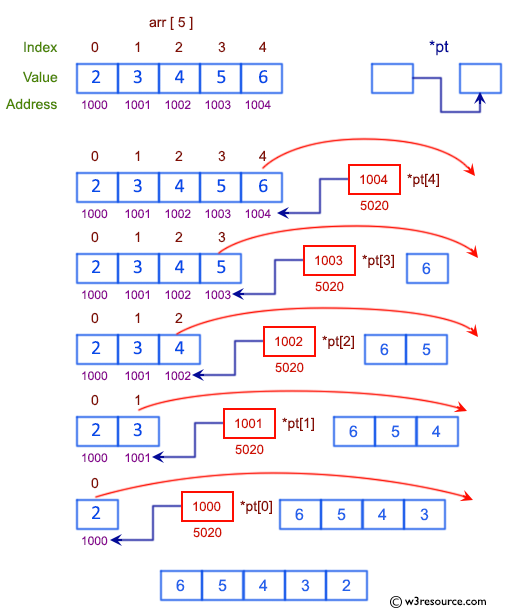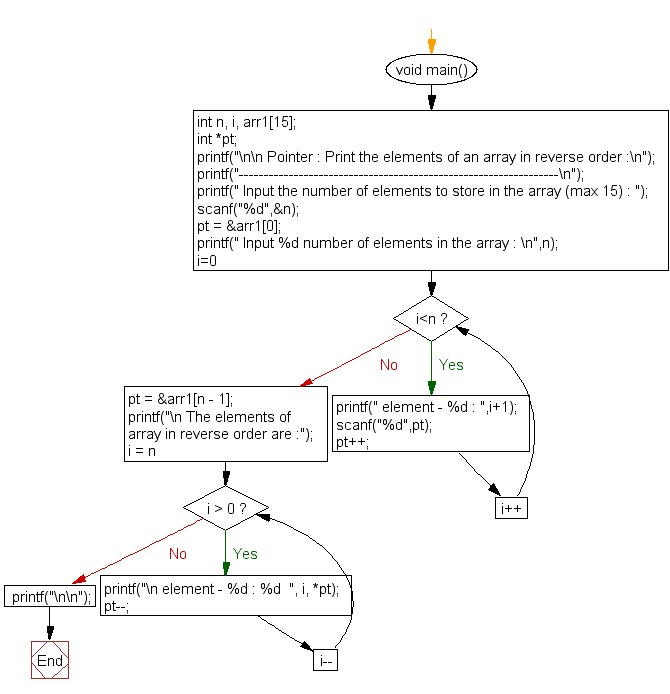C Exercises: Print the elements of an array in reverse order
C Pointer : Exercise-17 with Solution
Write a program in C to print the elements of an array in reverse order.
Pictorial Presentation:

Sample Solution:
C Code:
#include <stdio.h>
void main()
{
int n, i, arr1[15];
int *pt;
printf("\n\n Pointer : Print the elements of an array in reverse order :\n");
printf("----------------------------------------------------------------\n");
printf(" Input the number of elements to store in the array (max 15) : ");
scanf("%d",&n);
pt = &arr1[0]; // pt stores the address of base array arr1
printf(" Input %d number of elements in the array : \n",n);
for(i=0;i<n;i++)
{
printf(" element - %d : ",i+1);
scanf("%d",pt);//accept the address of the value
pt++;
}
pt = &arr1[n - 1];
printf("\n The elements of array in reverse order are :");
for (i = n; i > 0; i--)
{
printf("\n element - %d : %d ", i, *pt);
pt--;
}
printf("\n\n");
}
Sample Output:
Pointer : Print the elements of an array in reverse order :
----------------------------------------------------------------
Input the number of elements to store in the array (max 15) : 5
Input 5 number of elements in the array :
element - 1 : 2
element - 2 : 3
element - 3 : 4
element - 4 : 5
element - 5 : 6
The elements of array in reverse order are :
element - 5 : 6
element - 4 : 5
element - 3 : 4
element - 2 : 3
element - 1 : 2
Flowchart:

C Programming Code Editor:
Have another way to solve this solution? Contribute your code (and comments) through Disqus.
Previous: Write a program in C to compute the sum of all elements in an array using pointers.
Next: Write a program in C to show the usage of pointer to structure.
What is the difficulty level of this exercise?
Test your Programming skills with w3resource's quiz.
C Programming: Tips of the Day
Static variable inside of a function in C
The scope of variable is where the variable name can be seen. Here, x is visible only inside function foo().
The lifetime of a variable is the period over which it exists. If x were defined without the keyword static, the lifetime would be from the entry into foo() to the return from foo(); so it would be re-initialized to 5 on every call.
The keyword static acts to extend the lifetime of a variable to the lifetime of the programme; e.g. initialization occurs once and once only and then the variable retains its value - whatever it has come to be - over all future calls to foo().
Ref : https://bit.ly/3fOq7XP
- New Content published on w3resource:
- HTML-CSS Practical: Exercises, Practice, Solution
- Java Regular Expression: Exercises, Practice, Solution
- Scala Programming Exercises, Practice, Solution
- Python Itertools exercises
- Python Numpy exercises
- Python GeoPy Package exercises
- Python Pandas exercises
- Python nltk exercises
- Python BeautifulSoup exercises
- Form Template
- Composer - PHP Package Manager
- PHPUnit - PHP Testing
- Laravel - PHP Framework
- Angular - JavaScript Framework
- Vue - JavaScript Framework
- Jest - JavaScript Testing Framework
